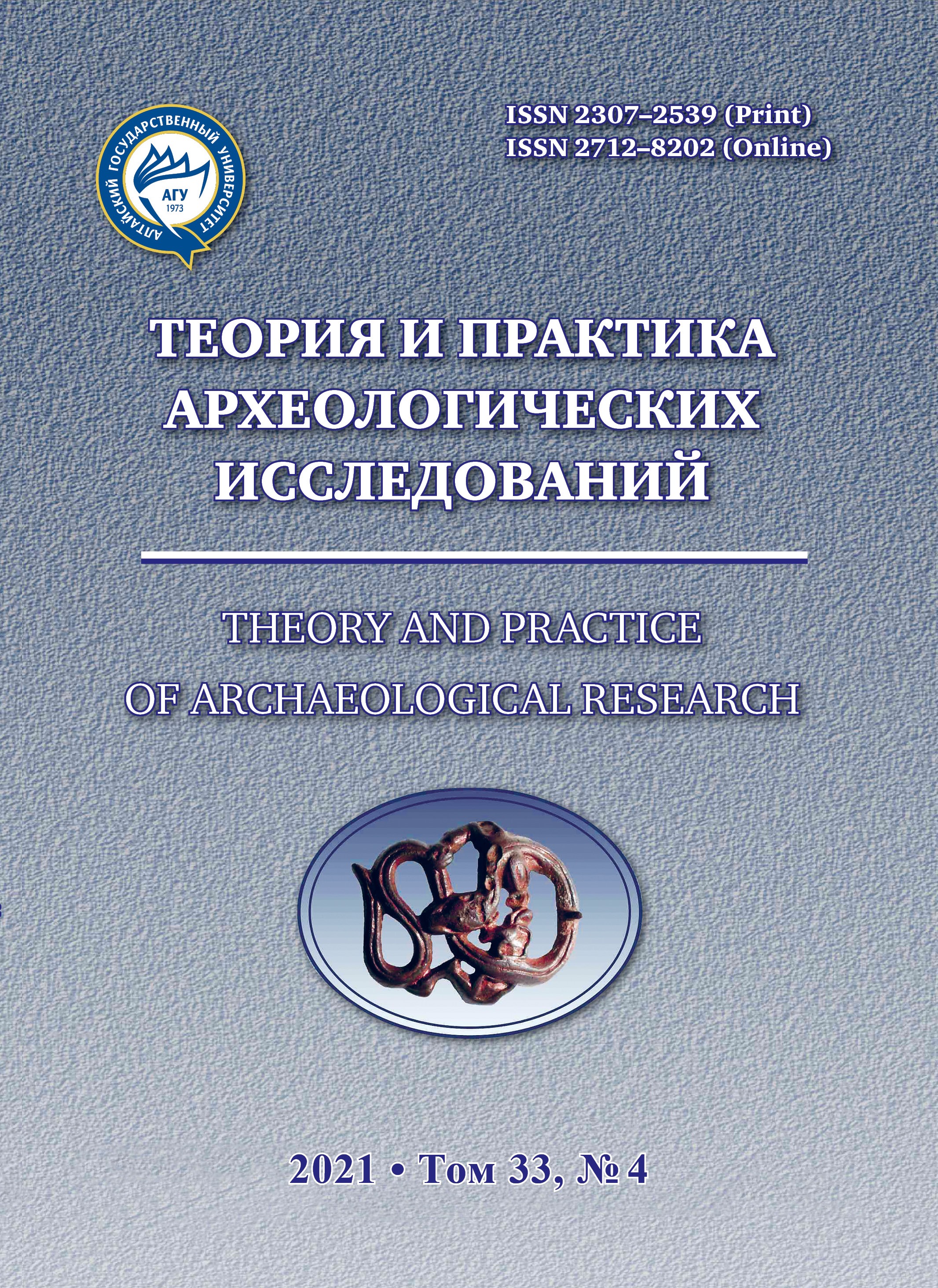Burial Complexes and Ritual Practices of the Yayoi Culture, Japanese Archipelago
Abstract
In the 1st millennium BC in Western Japan, emergency a new cultural tradition, which was different from the Jōmon Period. If in an early stage (approx. 10th — 8th centuries BC), during the transitional phase, was peaceful coexistence between the Jomon and Yayoi populations, then during the period from the 7th century BC to the 3rd century AD we can see a change from the economy of hunter–gathering to the producing one (agriculture, animal husbandry); the emergence of new technologies (metallurgy), innovation in the funeral rite and the social structure of Yayoi society. As a result of the gradual expansion of settlers from the Korean Peninsula, the Jōmon cultural tradition practically ceases to exist in most of the archipelago, with the exception of local variants on Hokkaido and Ryukyu Islands. In a number of popular science publications, we can read that these events and their significance for the territory of the Japanese archipelago are to a certain extent comparable with the discovery of the New World by Europeans and the subsequent dramatic destinies of the aborigines. The only difference is in the scale of the territories and in the fact that the Europeans actually interrupted the evolution of state and early state societies in pre–Columbian America, and on the territory of the Japanese islands, migrants from the continent, on the contrary, stimulated the emergence of proto–state formations. However, the process of introducing a new culture and accompanying technologies in reality was much more complicated, differed in different regions of the archipelago in its dynamics and degree of continuity with the previous Jōmon culture.
Downloads
Metrics
No metrics found.
References
Gnezdilova I.S. “Kofun–jidai” — “Epoch of Mounds” in Japan: History of Archaeological Research. Gumanitarnye nauki v Sibiri = Humanitarian Sciences in Siberia. 2015;22(2):60–64 (In Russ.)
Gnezdilova I.S. Wooden Ritual Objects on the Mounds of the Kofun Period of the Japan. Gumanitarnye nauki v Sibiri = Humanitarian Sciences in Siberia. 2018;25(2):43–48 (In Russ.) DOI: 10.15372/HSS20180207
Gnezdilova I.S., Ivanova D.A. The Tradition of Monumental Constructions in Ancient Cultures of the Japanese Archipelago: The Kofun Period. Vestnik Tomskogo gosudarstvennogo universiteta = Tomsk State University Journal. 2018;428:78–86 (In Russ.) DOI: 10.17223/15617793/428/10
Ivanova D.A. The Middle Jōmon Period of Honshu Island (5–4 Thousand Years Ago): General Characteristics and Local Features: Dissertation … Candidate of Hist. Sciences. Novosibirsk, 2018a. №1. 386 p. (In Russ.)
Ivanova D.A. The Middle Jōmon Period of Honshu Island (5–4 Thousand Years Ago): General Characteristics and Local Features: Dissertation … Candidate of Hist. Sciences. Novosibirsk, 2018b. №2. 164 p. (In Russ.)
Ivanova D.A., Popov A.N., Tabarev A.V. Secondary Burials in Clay Vessels in Jomon Culture on the Territory of Northern Japan. Vestnik Novosibirskogo Gosudarstvennogo Universiteta. Serija: Istorija, filologija = Vestnik Novosibirskogo Gosudarstvennogo Universiteta. Seriya: Istoriya, Filologiya. 2013;12(5):146–156 (In Russ.)
Ivanova D.A., Tabarev A.V. Shell Adormnents in Hirota Burial Complex, Tane Island, Japanese Archipelago. Problemy arkheologii, etnografii, antropologii Sibiri i sopredel’nykh territorii = Problems of Archaeology, Ethnography, Anthropology of Siberia and Neighboring Territories. 2018a; XXIV:264–268 (In Russ.) DOI: 10.17746/2658-6193.2018.24.264-268
Ivanova D.A., Tabarev A.V. Burial Practice of Jōmon Epoch, Japanese Archipelago (Based on the Materials of Kitamura Site). Camera Praehistorica. 2018b;1(1):77–93 (In Russ.) DOI: 10.33291/26583828.2018-(1)-4
Kasai Tsutomu. Burial Jars on the North Tohoku Region. In: Handbook of Jōmon Pottery. Tokyo : UM Promotion, 2008. Pp. 1092–1097 (In Japan.).
Kato Masashi. Stone Coffin Burials of the Late–Final Jo: Mona in the Kanto and Chubu Areas. In: Death and Burial — Funerary Practice. Tokyo : Dōseishya, 2007. Iss. 9. Pp. 58–69 (In Japan.).
Kodama Daisei. The Secondary Burial Practice in the North Part of the Tohoku Region. Death and Burial — Funerary Practice. Tokyo : Dōseishya, 2007. Iss. 9. Pp. 58–69 (In Japan.).
Kondo Yoshiro. Tatetsuki Yayoi Mound Tomb. Tokyo : Iwanami shyoten, 2002. 153 p. (In Japan.).
Miyamoto Kazuo. Yayoi Culture as an Area of Direct Distribution of Agricultural of the Korean Peninsula. Archaeology of Yayoi Period. A Short Description of Yayoi Culture. Tokyo : Dōseishya, 2009. Iss. 1. Pp. 35–51 (In Japan.).
Nakanozo Satoru. Kyushu. Archaeology of Yayoi Period. The Implements of Yayoi Society. Tokyo : Dōseishya, 2009. Iss. 6. Pp. 43–52 (In Japan.).
Nakamura Kōsaku. Buried in a graveyard. Handbook of Jōmon Pottery. Tokyo : UM Promotion, 2008. Pp. 1110–1115 (In Japan.).
Nakahashi Takahiro. Ritual Tooth-Ablation in Doigahama Yayoi People. Jinruigaku zasshi = Journal of the Anthropological Society of Nippon. 1990;99(4):483–505 (In Japan.).
Nesterkina A.L., Solovieva E.A., Gnezdilova I.S. Cultural Interaction Patterns in the Bronze Age: Ritual Bronze Artifacts from Korea and Japan. Arheologija, jetnografija i antropologija Evrazii = Archaeology, Ethnology and Anthropology of Eurasia. 2019;47(3):68–73 (In Russ.) DOI: 10.17746/1563-0102.2019.47.3.068-073
Nesterkina A.L., Solovieva E.A., Tabarev A.V., Ivanova D.A. The Megaliths of Korea and Japan: An Analysis of Origins and Functions. Arheologija, jetnografija i antropologija Evrazii = Archaeology, Ethnology and Anthropology of Eurasia. 2017;45(3):106–114 (In Russ.) DOI: 10.17746/1563-0102.2017.45.3.106-114
Rakov V.A. Images of Animals on the Ritual Bronze Dotaku Bells of the Yayoi Culture in Japan. The World of Ancient Images in the Far East. Pacific Archeology. Vladivostok : Izdvo Dal’nevostochnogo un-tа, 1989. Iss. 10. Pp. 123–136 (In Russ.)
Sichida Tadaaki. Yoshinogari Site, the Capital of Yamatai Country. Learn the Ruins. Tokyo: Shinsensha, 2017. №115. 93 p. (In Japan.).
A Bronze Sword and a Bronze Head Ornament Were Excavated from the Suku Okamoto Site (In Japan.) URL: https://www.city.kasuga.fukuoka.jp/miryoku/history/historymuseum/1002227/1002236 (accessed 17.10.2021)
Tabarev A.V., Ivanova D.A. Ladies of the Mirrors: Peculiarities of the Burials Goods in Yayoi culture, Japanese Archipelago. Gumanitarnye nauki v Sibiri = Humanitarian Sciences in Siberia. 2016;23(2):15–18 (In Russ.)
Tabarev A.V., Ivanova D.A. Ancient Cultures from the Southern Part of Japanese Archipelago: The Ryukyu Island. Mul’tidisciplinarnye issledovanija v arheologii = Multidisciplinary Research in Archaeology. 2019;1:13–19 (In Russ.)
Tabarev A.V., Ivanova D.A., Nesterkina A.L., Solovieva E.A. The Jōmon Megalithic Tradition in Japan: Origins, Features, and Distribution. Arkheologiya, etnografiya i antropologiya Evrazii = Archaeology, Ethnology and Anthropology of Eurasia. 2017;54(4):45–55. (In Russ.) DOI: 10.17746/1563–0102.2017.45.4.045–055.
Takahashi Ryuzanburo. Burials in Abandoned Dwellings of the Middle Jōmon Period in the Kanto Region. Death and Burial — Funerary Practice. Tokyo : Dōseishya, 2007. Iss. 9. Pp. 45–57 (In Japan.).
Fujiwara Hideki. Burial Mound of the Jōmon Period in the Hokkaido Island. Death and Burial — Funerary Practice. Tokyo : Dōseishya, 2007. Iss. 9. Pp. 19–32 (In Japan.).
Fujio Shin’ichirō. Jar Burial from Kyushu Island. Distribution of Jar Coffin Tombs in the Yayoi Period and Their Transition. Kokuritsu rekishi minzoku hakubutsukan kenkyū hōkoku = The Bulletin National Museum of Japanese History Research. 1989;21:141–206 (In Japan.).
Harunari Hideki. The Ritual Tooth-Ablation. Researching of the Yayoi culture. Rite, burial, clothing. Tokyo : Yuzangaku, 1996. Iss. 8. Pp. 79–90 (In Japan.).
Yayoi bunka. Yayoi Culture. Searching for the Origin of Japanese Culture. Izumi : Ōsaka furitsu yayoi bunka hakubutsukan, 1991. 252 p. (In Japan.).
Yoshinogari Historical Park, Place Where You Can Hear the Voice of the Yayoi People (In Japan). URL: https://www.yoshinogari.jp/ (accessed 17.10.2021)
An Illustrated Companion to Japanese Archaeology / Ed. Werner Steinhaus, Simon Kaner, Megumi Jinno, Shinya Shoda. Oxford: Archaeopress, 2020. 341 p.
Fujio S. Early Grain Cultivation and Starting Processes in the Japanese Archipelago. Quaternary. 2021;4(1):1–15.
Mizoguchi K. The Yayoi and Kofun Periods of Japan. Handbook of East and Southeast Asian Archaeology / Ed. Junko Habu, Peter V. Lape, John W. Olsen. New York : Springer, 2017. P. 561–601.
Nojima H. Emergence and Development of Burial Mounds in the Yayoi Period. Burial Mounds in Europe and Japan. Comparative and Contextual Perspectives / Ed. by Thomas Knopf, Werner Steinhaus, Shin’ya Fukunaga. Oxford : Archaeopress Publishing Ltd, 2018. Pp. 57–68.
Theory and Practice of Archaeological Research is a golden publisher, as we allow self-archiving, but most importantly we are fully transparent about your rights.
Authors may present and discuss their findings ahead of publication: at biological or scientific conferences, on preprint servers, in public databases, and in blogs, wikis, tweets, and other informal communication channels.
Theory and Practice of Archaeological Research allows authors to deposit manuscripts (currently under review or those for intended submission to ABS) in non-commercial, pre-print servers such as ArXiv.
Authors who publish with this journal agree to the following terms:
- Authors retain copyright and grant the journal right of first publication with the work simultaneously licensed under a Creative Commons Attribution License (CC BY 4.0) that allows others to share the work with an acknowledgement of the work's authorship and initial publication in this journal.
- Authors are able to enter into separate, additional contractual arrangements for the non-exclusive distribution of the journal's published version of the work (e.g., post it to an institutional repository or publish it in a book), with an acknowledgement of its initial publication in this journal.
- Authors are permitted and encouraged to post their work online (e.g., in institutional repositories or on their website) prior to and during the submission process, as it can lead to productive exchanges, as well as earlier and greater citation of published work (See The Effect of Open Access).








2.jpg)




